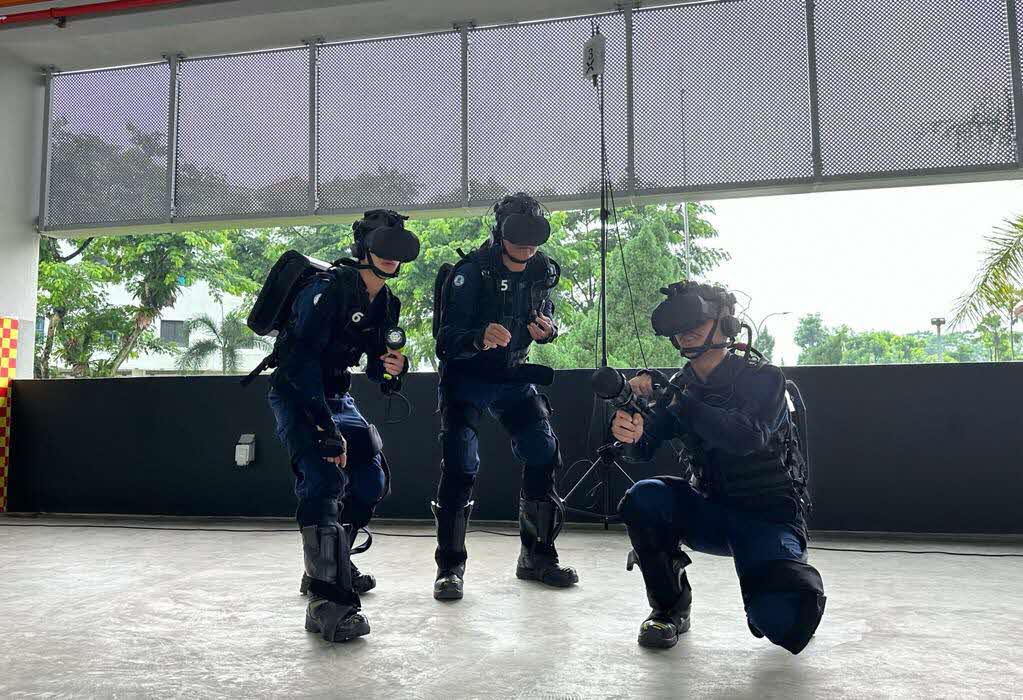 SCDF officers in action during a VR training session held at the Civil Defence Academy (CDA). (Photo: HTX)
SCDF officers in action during a VR training session held at the Civil Defence Academy (CDA). (Photo: HTX)
The boundaries of our physical reality have long been pushed by Virtual Reality (VR) and Augmented Reality (AR). What’s the difference? VR immerses a user in a fully virtual environment while AR overlays digital content on top of the real world (think Snapchat filters). Then there’s Mixed Reality (MR) which, as the name suggests, integrates VR and AR.
Extended Reality (XR), on the other hand, is the newest kid on the block. It comprises all three – VR, AR, and MR – and combines the physical and virtual spaces together.
While XR is yet to be available commercially, we’re using this latest tech in the Home Team’s public safety efforts by incorporating it into our simulation training to level it up.
Working with the National University of Singapore (NUS) CUTE (Connective Ubiquitous Technology for Embodiments) Center under the NUS Smart Systems Institute, HTX and SCDF developed an XR system with immersive and interactive elements to train SCDF officers in managing Road Traffic Accidents (RTA) and Hazardous Materials (HazMat) incidents.
Suit up to engage your senses
The XR system features a Multi-Sensory Suit (MAV Suit) which provides haptic feedback to officers and gives off smells, such as smoke, that you’d encounter in a live-fire scenario. The suit’s vest also emits heat so the officer wearing it would feel as if he were at an actual fire ground. This innovative system is the first of its kind because these haptic elements were not available in previous simulation suits.
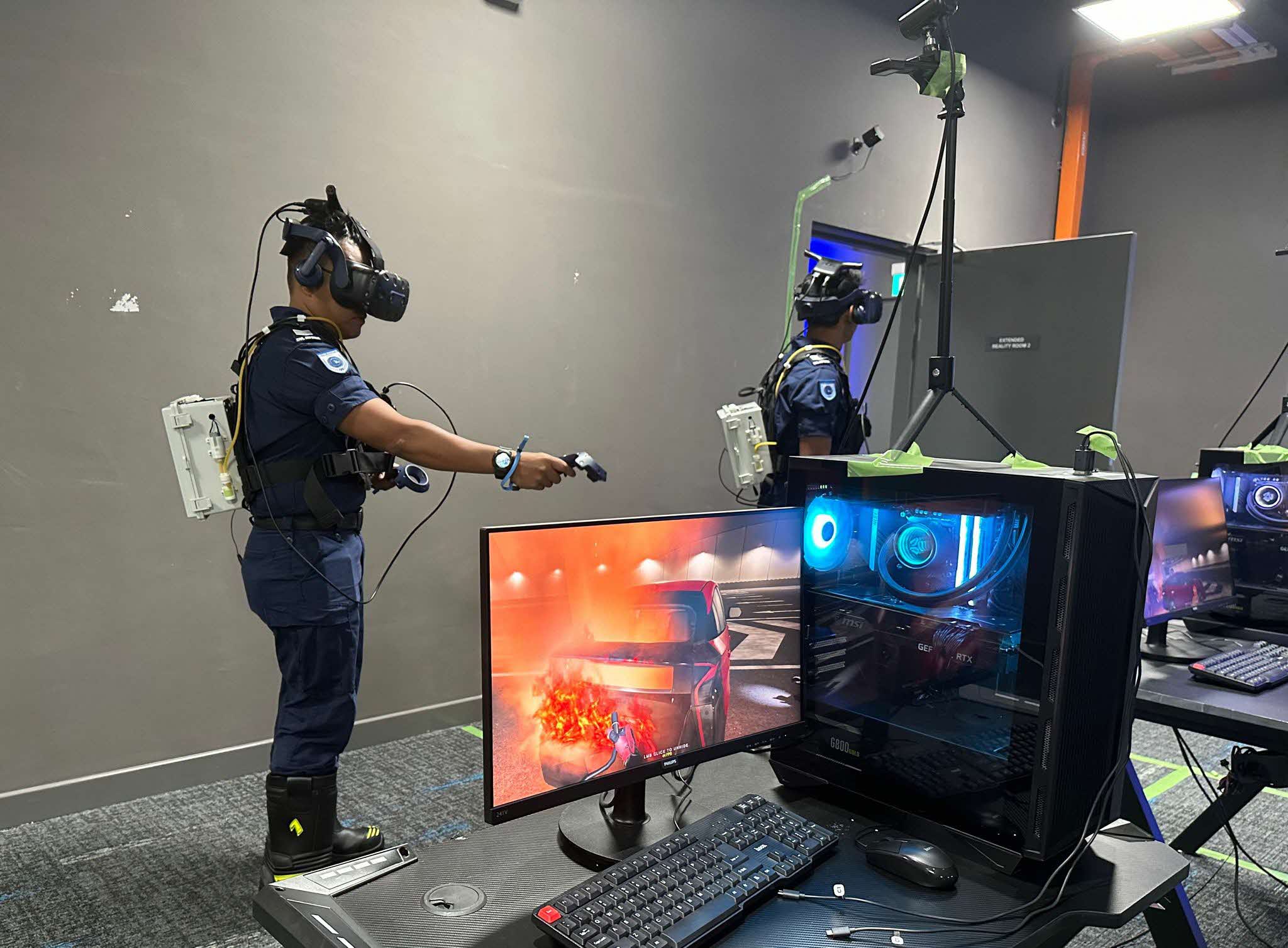 As part of the training, SCDF officers wear VR headsets and MAV suits to immerse themselves in the simulation and use remote controllers to navigate the virtual world. The SCDF officer to the left is using a remote controller to put out a fire in the VR simulation. (Photo: HTX)
As part of the training, SCDF officers wear VR headsets and MAV suits to immerse themselves in the simulation and use remote controllers to navigate the virtual world. The SCDF officer to the left is using a remote controller to put out a fire in the VR simulation. (Photo: HTX)
Realistic mock-ups
In a real-life RTA scenario, firefighters will first put out any fires before ensuring that the vehicle is stabilised so that they can safely operate on it without it moving. They will then attempt to remove the vehicle door with a spreader cutter so that they can extricate the unconscious casualty trapped inside.
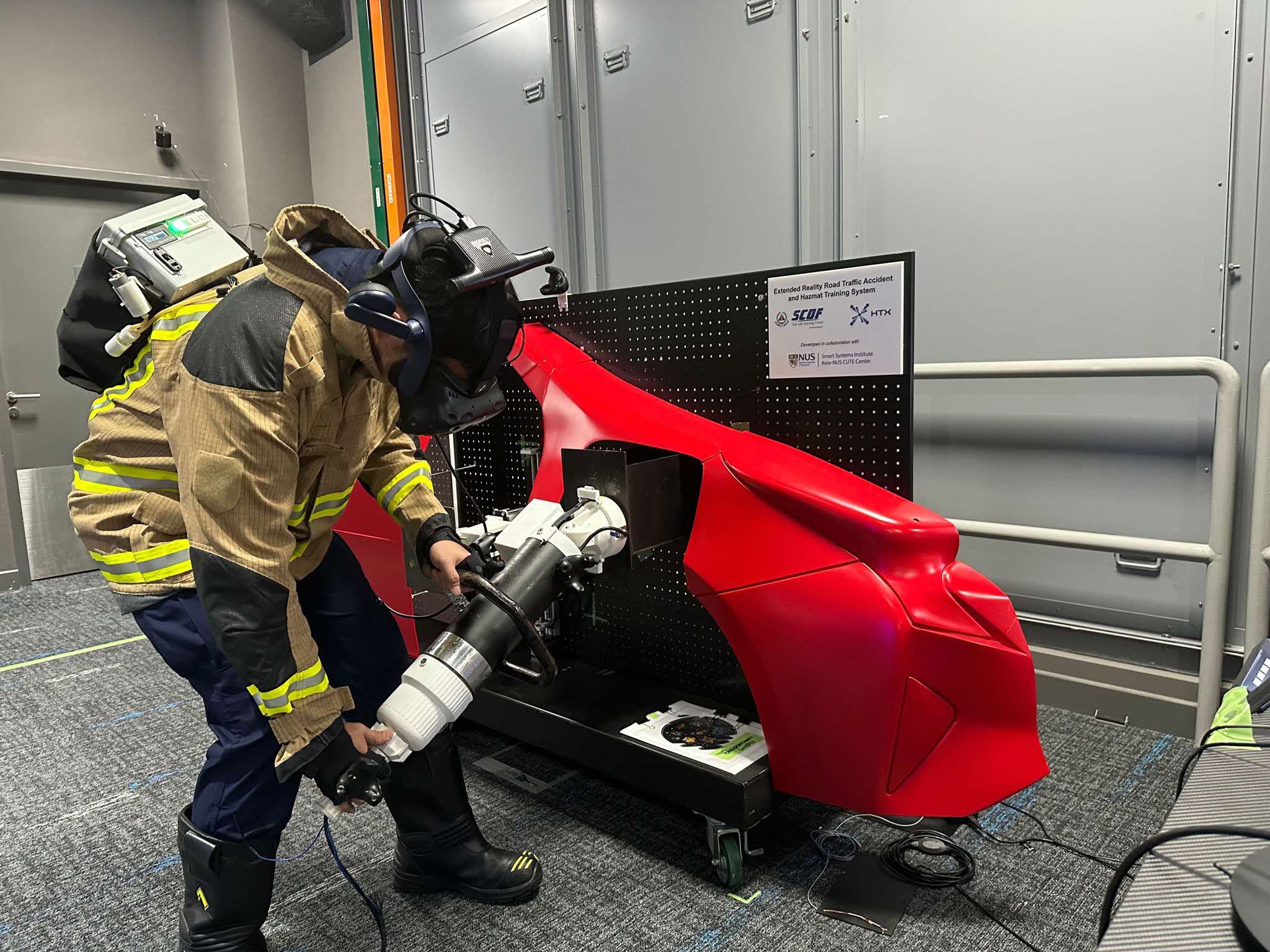 The XR set-up for RTA simulation training. (Photo: HTX)
The XR set-up for RTA simulation training. (Photo: HTX)
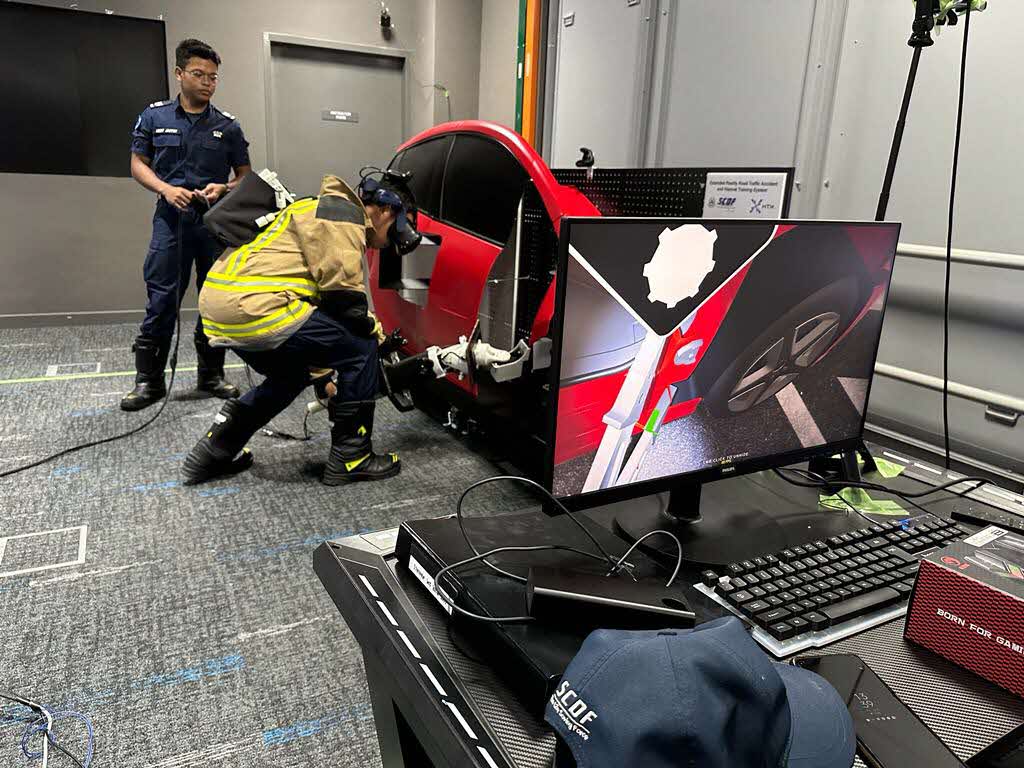 An instructor monitors the trainee’s performance from a computer, while another officer is on standby to assist. (Photo: HTX)
An instructor monitors the trainee’s performance from a computer, while another officer is on standby to assist. (Photo: HTX)
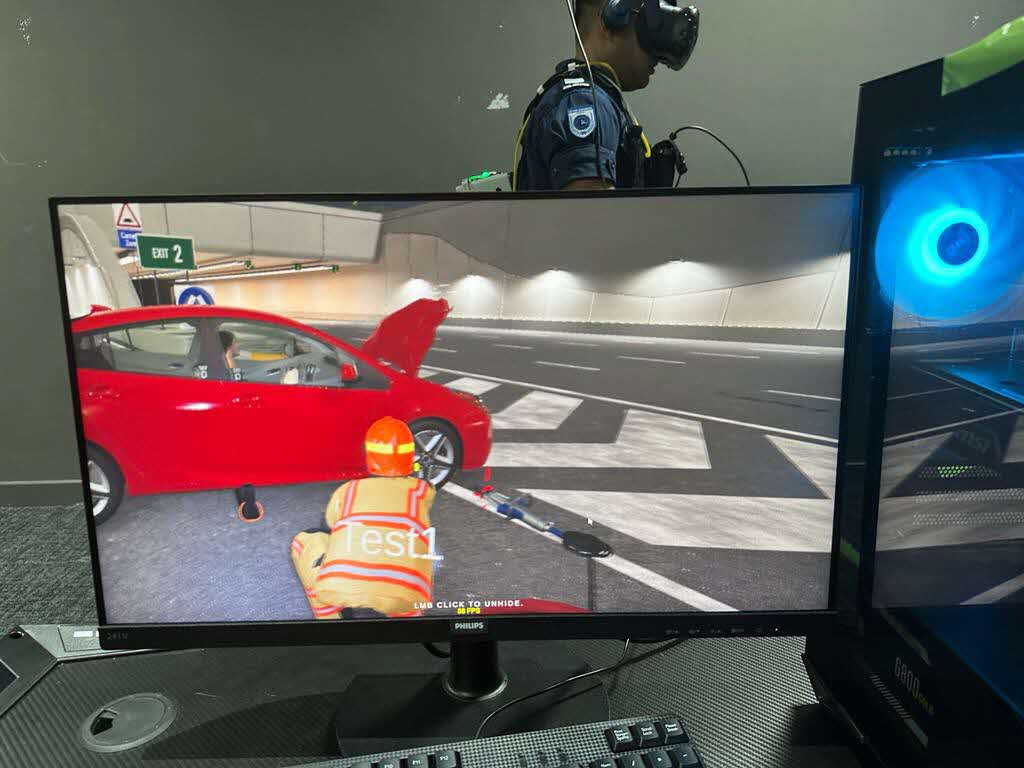 The POV of a trainee watching his teammate as the latter works to stabilise the vehicle after the fire has been put out. (Photo: HTX)
The POV of a trainee watching his teammate as the latter works to stabilise the vehicle after the fire has been put out. (Photo: HTX)
This system is a step up from the usual RTA and HazMat training methods where designated wreckage sites with scrap cars are typically used. However, scrap cars are costly to acquire, and actual chemicals cannot be used for HazMat trainings because of safety and environmental concerns. With XR, trainings can be safely carried out with minimal setup. Training scenarios can also be customised to include different vehicles such as lorries and buses, which are not easily purchasable as scrap vehicles.
Other than NUS, HTX and SCDF also worked with RE-liON, a defence training software developer from the Netherlands, to develop a VR system that can now recreate and customise different building-fire scenarios.
Customisable realities with VR
In a computer-controlled environment, firefighters don a RedSuit that can emit heat like the MAV Suit. The gear comes with a mock-up of the firefighting nozzle which recreates the sensation of different water pressures, adding to the physical and virtual experience for trainees.
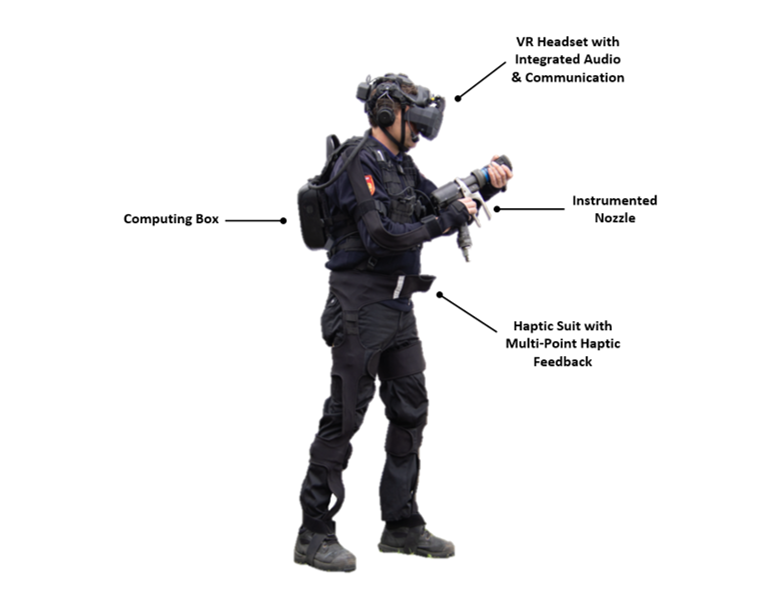 Components of a RedSuit. It has built-in sensors which track the location and movements of trainees in the virtual world. (Photo: HTX)
Components of a RedSuit. It has built-in sensors which track the location and movements of trainees in the virtual world. (Photo: HTX)
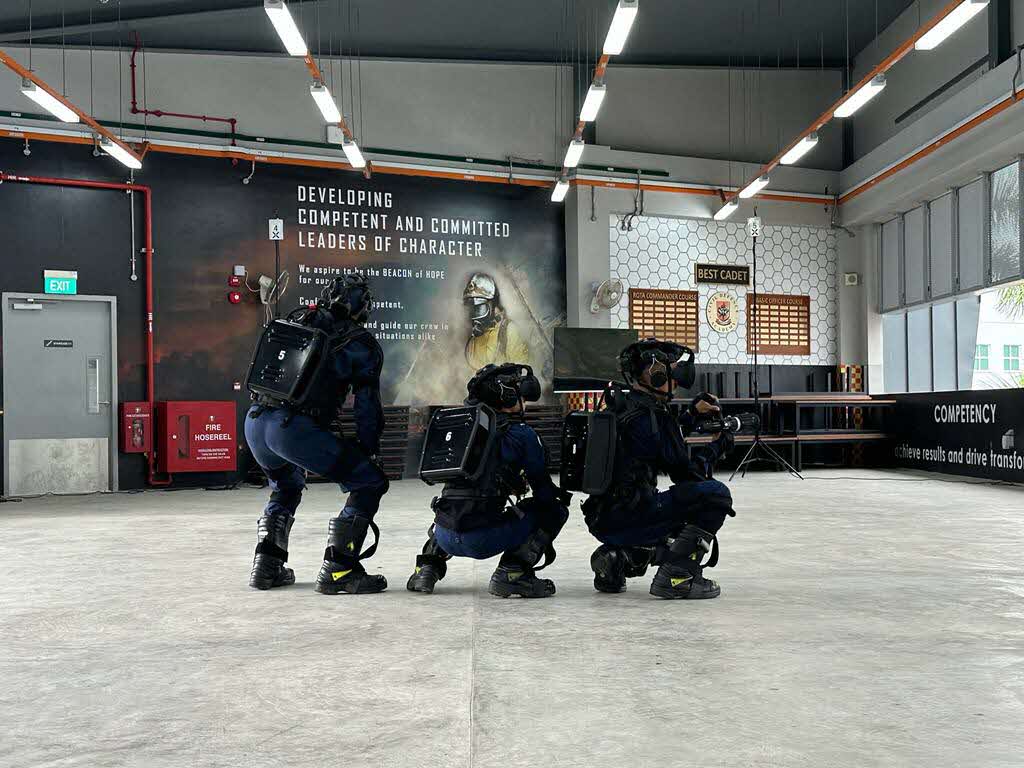 Training ground of SCDF officers in a VR simulation. (Photo: HTX)
Training ground of SCDF officers in a VR simulation. (Photo: HTX)
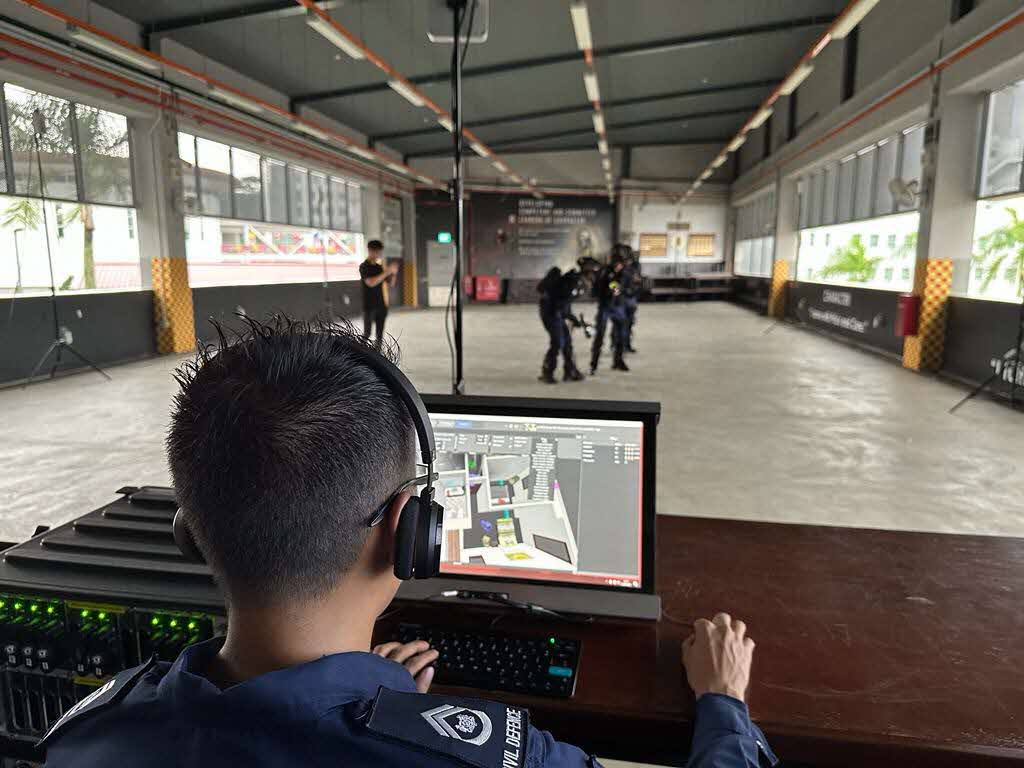 Trainees are mapped as avatar characters on a computer screen where every action and movement can be detected. In this photo, an instructor watches the trainees navigate a room from a floor-plan view. (Photo: HTX)
Trainees are mapped as avatar characters on a computer screen where every action and movement can be detected. In this photo, an instructor watches the trainees navigate a room from a floor-plan view. (Photo: HTX)
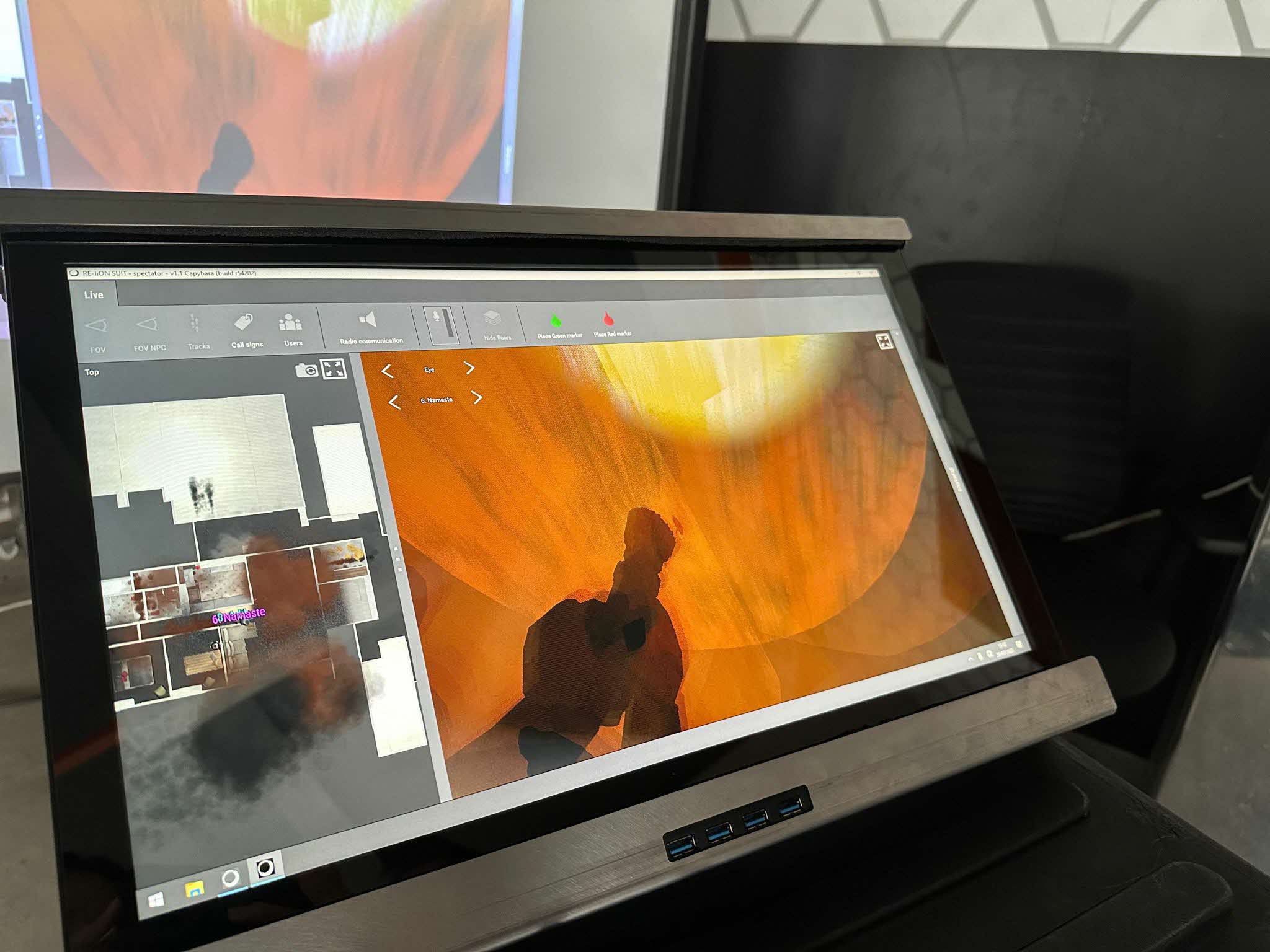 A trainee’s POV as he goes through the VR training. (Photo: HTX)
A trainee’s POV as he goes through the VR training. (Photo: HTX)
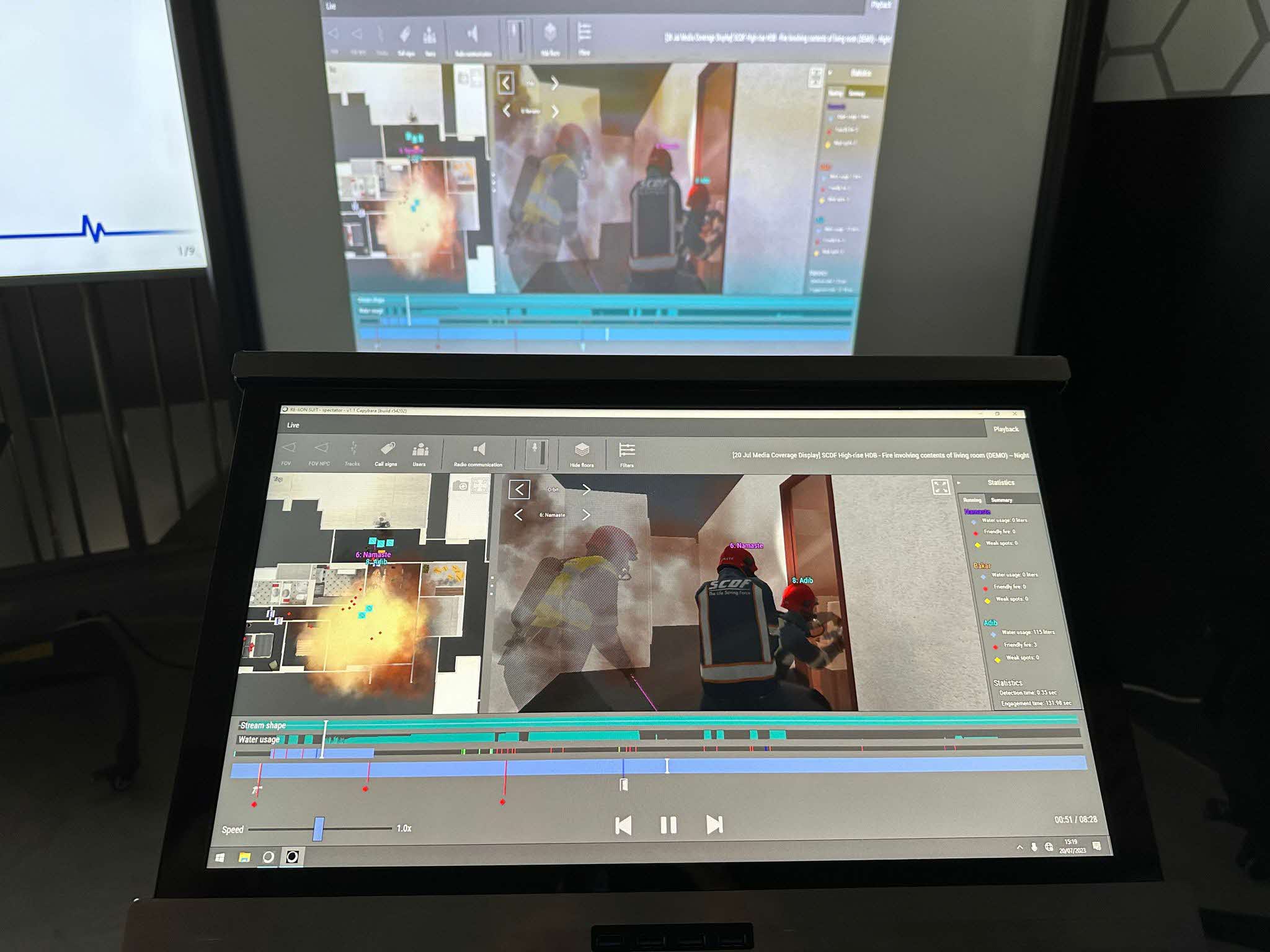 A replay of a VR simulation set in a building on fire. (Photo: HTX)
A replay of a VR simulation set in a building on fire. (Photo: HTX)
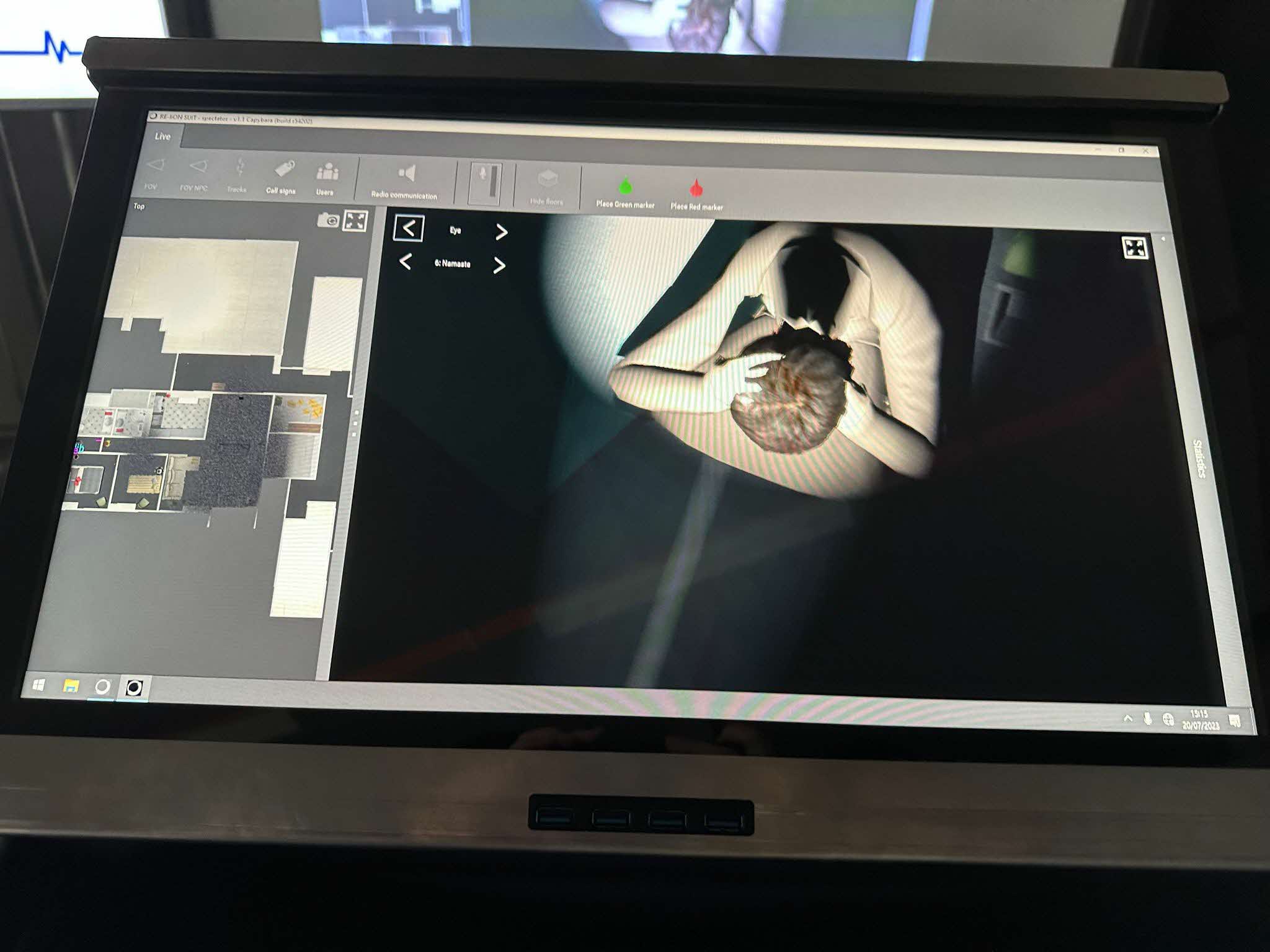 A casualty spotted from the POV of a trainee. (Photo: HTX)
A casualty spotted from the POV of a trainee. (Photo: HTX)
Efforts to make these training systems deployable have been underway since over a year ago. The XR system started at the end of 2021 while the VR firefighting system project started in March 2022. Both these systems are currently on trial and used for small group trainings. Once successful, SCDF is looking to scale them up for use in larger group training.
Can these technologies replace real-life training?
While VR and XR can provide the flexibility and ease of carrying out different firefighting training with enhanced realism, they are not here to completely replace hands-on training. Rather, these XR and VR systems will be used to supplement the usual theory and practical training of officers to enhance their tactical firefighting proficiency, situational response, and decision-making skills.
Dr Saravana Kumar Kumarasamy, the Deputy Director of Modelling & Simulation (M&S) at the Human Factors & Simulation (HFS) Centre of Expertise (CoE), heads these projects, and is realistic when it comes to using XR and VR for simulation training.
“We are not trying to replace conventional methods, but rather progressively raise the bar for simulation training,” he said. “It’s a step up from ‘classroom’ learning, but you cannot remove the field training for many years to come.”
“Still,” Dr Saravana continued, “there are obvious benefits to incorporating XR and VR into existing training. The systems allow officers to practise their skills in a controlled environment where they can experiment, learn, and adapt without being restricted by real-world limitations. We are continuously working with partners to enhance the situational realism in simulations, such as through the creation of novel senses and development of miniaturised devices that can be integrated into the headsets or haptic suits.”
Terence Teng, Lead Engineer at the HFS CoE, who is involved in these projects, added, “Trialling the different aspects of XR and haptic feedback helps us to find and gather the right technological pieces to build a complete XR training platform. This will not only revolutionise how we experience the virtual world through enhanced sensory fidelity, but also level up Home Team training.”
Lieutenant Colonel Foo Yiing Kai, Commander of Punggol Fire Station, says that the collaboration has been beneficial as it allowed each organisation to bring their unique skills, ideas, and perspectives together.
“It’s a system that will bring about greater training effectiveness and learning efficiency for my trainees,” he commented. “They are now better able to practice and refine their techniques and skills in a safe environment.”
We might still be quite a long way from XR games being available like VR or AR games, but by stepping up our Home Team trainings with these technologies, new and exciting possibilities are opening up for our officers so that they are ever-ready to safeguard our homeland.
Addendum: The Extended Reality (XR) innovation project for simulation training and monitoring of training sessions received the Regional (Asia) Gold Award at the QS Reimagine Educational Awards & Conference which was held at Khalifa University, Abu Dhabi from 11 to 13 December 2023.
This project was also showcased at the Milipol Asia-Pacific – TechX Summit exhibition held at the Marina Bay Sands convention centre from 3 to 5 April 2024.

